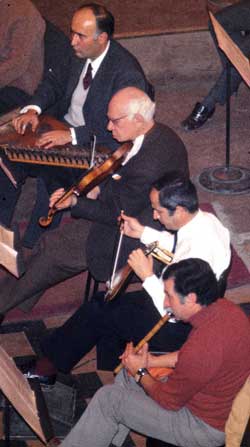|
Summary
Two decades ago, music historian Joseph Kerman said, "Notes, pitches, harmonies, tone colors can be thought of as defining rhythm. In other words, they sharpen, articulateput a particular kind of inflection on rhythms." That started me thinking about time in a broader sense. More recently, ethnomusicologist Marcello Sorce Keller touched on time in a way that further stimulated my thinking, "Processes that the listener may respond to as rhythm can come from virtually anywhere, including ... recurrent peaks in a melodic line, changes in timbre, texture, dynamics, or source of melodic activity, or interactions among any combination of such ingredients." I'd like to see a continuing dialogue on musical time.
Questions and answers Q. "You've mentioned of an interaction. So, what are the main differences between rhythmical layers of religious music (specifically Ayin-i Şerif) and those of court music? What is the most significant point in sacred music that distinguishes it from court music?" A. The number of usuls is much more limited in the Mevlevi Ayini. For example, the peşrev (instrumental prelude) usul is always Muzaaf Devri Kebir and the Third Selam almost always uses the usul sequence of Devri Kebir + Aksak Semai + Yürük Semai. Rhythmically speaking, the overwhelming predominance of the kudüm playing the velveleli usul significantly distinguishes the Mevlevi music from secular court music. Percussion, if played at all in court music, is simpler, more subtle. More details Q. "What is the relationship between the bow by the mutrip with the rhythm of the piece? Do you believe that the practice of the salutation is an inherent part of the music? A. Yes, I do. The answer to this question depends on one's definition of music. For performers and spectators alike, significant "extramusical" events such as the solemn procession around the hall (Sultan Veled Devri) and the salutations by the mutrip could be considered inseparable from "musical" events punctuating the timeline. See also Vicente 2007. |
